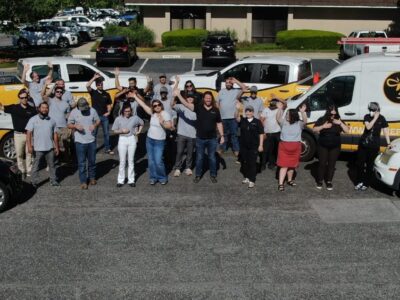(Bloomberg) —
Google’s co-founder and Alphabet Inc.’s moonshot lab X are making a bet on a technology that has struggled to break through: carbon removal.
Sergey Brin and San Francisco 49ers co-owner Gideon Yu are among the backers of 280 Earth, an under-the-radar startup that uses industrial waste heat to power machines that suck carbon out of the air. The company received $15 million from Catalyst4, a half-billion-dollar nonprofit that Brin recently launched, largely using proceeds from the sale of Tesla shares.
Tech companies, including Alphabet, and major investors like Bill Gates and now Brin — the tenth-richest person in the world with a net worth of $122.2 billion, according to the Bloomberg Billionaires Index — have made big investments in carbon removal in recent years. That includes investing in startups as well as paying companies to pull carbon dioxide from the air. Despite the interest, the technology has yet to reach anywhere close to meaningful scale even as the deployment of wind, solar and batteries surge. 280 Earth is different from other efforts, though. Few, if any, major tech companies have been working on the technology in-house.
The startup is the first direct air capture (DAC) spinout for X, Alphabet’s division for cutting-edge technology launched by Google co-founders Brin and Larry Page. It takes a unique approach to DAC by using waste heat to power machines that pull carbon from the air, which could make it a tantalizing prospect for companies like Google that run massive data centers.
280 Earth “is a great example of what the Moonshot Factory was built for: inventing and testing radical new technologies to tackle the most complicated global challenges,” said Astro Teller, who leads the lab, in a statement.
It’s an example of X increasingly relying on funding from outside investors, as it shifts its focus to spinning out its projects as independent companies. Instrumental to spinning it out is the funding from Catalyst4, which is focusing on “efforts to mitigate and reverse the effects of climate change,” according to a filing with the Internal Revenue Service. 280 Earth filed for incorporation in 2022, California records show, and X retains equity in the startup and continues to co-develop the technology. Former X employee and DAC project lead Darren Bonnstetter left the lab to lead the newly independent company as chief executive officer.
In addition to Brin and Yu, San Francisco-based Builders VC is backing 280 Earth. Yu also sits on the board as executive chairman, alongside retired US Army General Gus Perna.
“All the conservation efforts just serve to slow the amount of water that’s flowing into the bathtub,” Yu, who is the former Facebook and YouTube CFO, said of cutting emissions. “There’s also going to have to be a release valve,” which in his view is where 280 Earth’s direct air capture technology fits in. Yu declined to comment on Brin’s involvement in the startup. A representative for Catalyst4 did not respond to requests for comment.
280 Earth broke ground on its commercial demonstration facility in August 2023 with an expected capacity to capture 500 tons of CO2 annually, with operations set to begin later this year. That amount is equivalent to the yearly CO2 emissions from about 100 car tailpipes.
That capacity is smaller than other DAC pilots like Climeworks’ plant in Iceland capable of removing 4,000 tons of CO2 annually and Heirloom Technologies’ California plant that opened last year with the ability to gather up to 1,000 tons of CO2 per year. But 280 Earth is concurrently developing a larger-scale module, which would capture 5,000 tons of CO2 per year. That would put it in the thick of the race to develop highly speculative technology that will nevertheless almost certainly be needed to avert the most catastrophic effects of climate change. Scientists estimate that the world will need to remove billions of tons of CO2 each year by mid-century.
Read more: A Startup Battles Big Oil for the $1 Trillion Future of Carbon Cleanup
Uniquely for DAC startups, 280 Earth uses waste heat from industrial facilities like data centers to power the carbon capture process. Its pilot facility is currently being constructed next to a Google data center in The Dalles, Oregon, which Bonnstetter called “a great place to find green energy and run our tests.” By using waste heat and operating at lower temperatures, both of which cut costs, he projected that 280 Earth will be able to remove a ton of CO2 for $200 by 2028. He declined to disclose the current cost.
The startup’s approach could be a tailor-made solution for one of Big Tech’s most challenging sources of emissions. Companies like Google own and operate massive data centers that collectively emit more carbon than the aviation industry, according to the World Economic Forum.
While the company has a goal of reaching net zero emissions by 2030 and is working to power its data centers with clean energy, it has also acknowledged that carbon removal technologies will need to play a role in helping meet its target. The rise of energy-intensive artificial intelligence is only adding urgency for Google and other data center operators that have set CO2 targets like Amazon and Microsoft.
“We’re looking across the US right now at various places,” to site DAC plants, Bonnstetter said. “One opportunity could definitely be data centers.”
Read more: AI Needs So Much Power That Old Coal Plants Are Sticking Around
280 Earth also relies on a unique setup that moves the chemicals that capture CO2 through the machine. Jacques Gagne, a X senior technical director who developed the technology and co-founded 280 Earth, likened it to a Henry Ford assembly line: “You move the car around the factory, not the factory around the car.”
That makes the system more efficient, he said, allowing 280 Earth to continuously capture CO2 and maximize its use of waste heat while minimizing the need for electricity, which has proven difficult for some other DAC systems.
The biggest challenge to scale the technology up, Bonnstetter said, will be building and growing a customer base. Although 280 Earth already has customers that will pay for its carbon removal services, Bonnstetter said, he would not disclose who those customers are.
“If we got the direct air capture below $100 [per ton], that sounds great, but there’s got to be somebody willing to pay the $100,” he said.
To contact the authors of this story:
Michelle Ma in Los Angeles at mma304@bloomberg.net
Biz Carson in San Francisco at bcarson28@bloomberg.net
© 2024 Bloomberg L.P.





